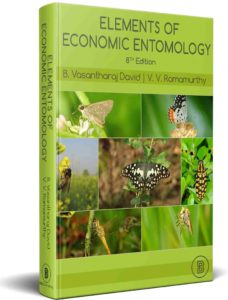The “Elements of Economic Entomology” series is a holistic compendium on Entomology. An essential textbook for all required to learn the essentials of Entomology. It places essentials of Economic Entomology on a simple platform to enable quick and authentic understanding and assimilation of studies and facts. All those details which enable deciphering of the insects in relation to humans are present. The basics of applied Entomology are here in a thorough and simplest mode. Enabling a beginner to imbibe all aspects together in the easiest route is the mark of this series. The beneficial and harmful aspects of insects are elaborated herein with examples in a systematic manner. The current requirements of Applied Entomology are updated in an accurate mode. The interactions between human and insects is a pivotal theme of the book. All insects are not harmful, it is essential that we know the productive and beneficial insects. The unproductive and harmful pests directly or indirectly inflict damage to humans, and these pests are brought out here in the minutest of the details. Much of these insects and pests in the book are common to Southeast Asian countries, Africa and other parts of the world. This is the only book of its kind which holistically provides such fundamentals along with principles and methods of their management. It provides all the recent and innovative aspects of Economic Entomology which one cannot miss dealing with insects in any
part of the world. This is a scientific accompaniment for every Entomologist, and those dealing with Insects, Zoology, Agriculture, Horticulture, Forestry, Medical, Public Health, Crop Protection, Veterinary Science, Plant Protection, Pesticides, Agricultural Chemicals and Industrial aspects of Entomology.
PART ONE: GENERAL
1. History of entomology in India
2. Economic importance of insects
PART TWO: BENEFICIAL INSECTS
3. Productive insects
4. Helpful insects
PART THREE: HARMFUL INSECTS
5. Insects: Their activities and balance of life
6. Pests of field, horticultural crops and plantations
7. Locusts
8. Pests of stored products
9. Insects in relation to plant diseases
10. Invasive pests
11. Pests of forest trees
12. Pests of domestic animals
13. Pests of public health and household
14. Pant mites
PART FOUR: NON-INSECT PESTS
15. Plant nematodes
16. Rats
17. Other non-insect pests
PART FIVE: PEST CONTROL
18. Methods and principles
A. Natural control
B. Applied or artificial control
C. Integrated pest management (IPM)
D. Frontier areas in pest management
19: Pesticides
A. Historical
B. Insecticide formulations
C. Mode of action
D. Classification
E. Inorganic compounds
F. Organic compounds
G. Synthetic organic insecticides
H. Organic sulphur compounds
I. Fumigants
J. Systemic insecticides
K. Principles of toxicology
20: Appliances and devices in pest control
A. Dusting and dusters
B. Spraying and sprayers
C. Aerosols
D. Insecticide smoke generator
E. Other equipments and devices
F. Aircraft application


